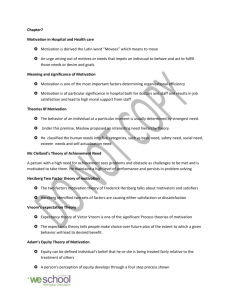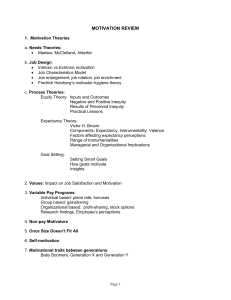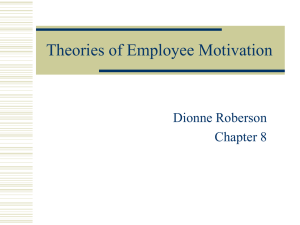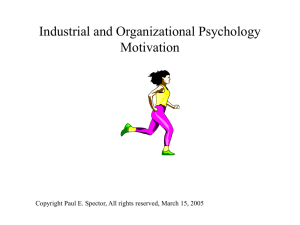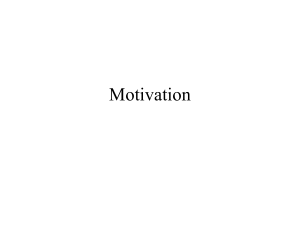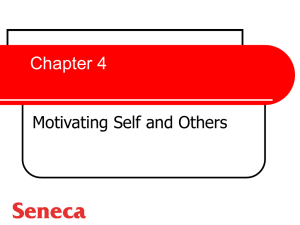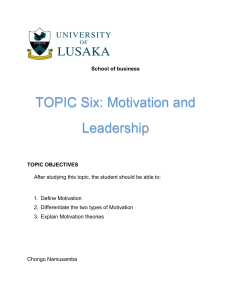Chapter 7
advertisement
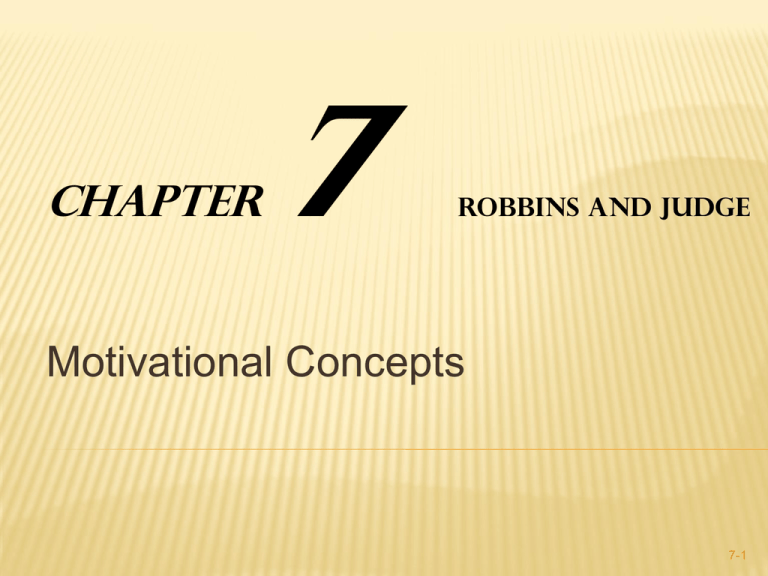
Chapter 7 Robbins and Judge Motivational Concepts 7-1 KEY ELEMENTS OF MOTIVATION Motivation is “the processes that account for an individual’s intensity, direction, and persistence of effort toward attaining a goal.” Many people incorrectly view motivation as a personal trait. Key Elements Intensity is concerned with how hard a person tries. Direction is the orientation that benefits the organization. Persistence is a measure of how long a person can maintain his/her effort. 7-2 EARLY THEORIES OF MOTIVATION - Maslow’s need theory has received wide recognition, particularly among practicing managers. - Research does not generally validate the theory. - Some researchers have attempted to revive components of the need hierarchy concept, using principles from 7-3 evolutionary psychology. EARLY THEORIES OF MOTIVATION: THEORY X & THEORY Y Theory X assumptions are basically negative. Employees inherently dislike work and, whenever possible, will attempt to avoid it. They must be coerced, controlled, or threatened with punishment. Theory Y assumptions are basically positive. Employees can view work as being as natural as rest or play. 7-4 THEORY X & THEORY Y The implications for managers are best explained by using Maslow’s framework: Theory X: lower-order needs dominate individuals. Theory Y: higher-order needs dominate individuals. McGregor himself believed that Theory Y assumptions were more valid than Theory X. No evidence to confirm that either of is valid. 7-5 EARLY THEORIES OF MOTIVATION 7-6 EARLY THEORIES OF MOTIVATION: TW0FACTOR THEORY 7-7 EARLY THEORIES OF MOTIVATION: TW0FACTOR THEORY Criticisms of Herzberg’s theory: Limited because it relies on self-reports. The reliability of methodology is questioned. No overall measure of satisfaction was utilized. Herzberg assumed a relationship between satisfaction and productivity, but the research methodology he used looked only at satisfaction, not at productivity. 7-8 CONTEMPORARY MOTIVATION THEORIES: SELF-EFFICACY THEORY Known also as social cognitive theory and social learning theory Self-Efficacy Theory Enactive mastery Vicarious modeling Verbal persuasion Arousal 7-9 SELF-EFFICACY THEORY Implications of Efficacy Theory Training programs often make use of enactive mastery by having people practice and build their skills. The best way for a manager to use verbal persuasion is through the Pygmalion effect or the Galatea effect. Intelligence and personality are absent from Bandura’s list, but they can increase self-efficacy. 7-10 EQUITY THEORY Which referent an employee chooses will be influenced by the information the employee holds about referents, as well as by the attractiveness of the referent. Gender, Length of tenure, Level in the organization, Professional ranks and higher education 7-11 EQUITY THEORY When employees perceive an inequity, they can be predicted to make one of six choices: Change their inputs. Change their outcomes. Distort perceptions of self. Distort perceptions of others. Choose a different referent. Leave the field. 7-12 EQUITY THEORY 7-13 EXPECTANCY THEORY Expectancy theory argues that a tendency to act in a certain way depends on an expectation that the act will be followed by a given outcome and the attractiveness of that outcome to the individual. An employee will be motivated to exert a high level of effort when he/she believes that: Effort will lead to a good performance appraisal. A good appraisal will lead to rewards. The rewards will satisfy his/her personal goals. 7-14 EXPECTANCY THEORY 7-15 EXPECTANCY THEORY AND EMPLOYEES MOTIVATION The key to expectancy theory is the understanding of an individual’s goals and the linkage between effort and performance, between performance and rewards, and finally, between the rewards and individual goal satisfaction. Some critics suggest that the theory has only limited use, arguing that it tends to be more valid for predicting in situations where effort-performance and performancereward linkages are clearly perceived by the individual. 7-16

